Themed collection Bioanalytical Sensors

Recent advances in boronic acid-based optical chemosensors
This minireview highlights the developments in optical chemosensors from 2014 to 2016 that utilise the boronic acid interaction with polyols or Lewis bases.

Analyst, 2017,142, 1403-1414
https://doi.org/10.1039/C7AN00439G
Single plasmonic nanoparticles as ultrasensitive sensors
In this mini review, we will provide a brief introduction focusing on the current applications of single plasmonic nanoparticle-based sensors using DFM, including the detection of molecules, the real-time monitoring of chemical/electrochemical reactions and the imaging of living cells.
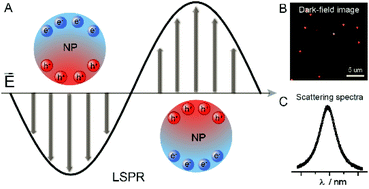
Analyst, 2017,142, 409-420
https://doi.org/10.1039/C6AN01852A
A unified approach for investigating chemosensor properties – dynamic characteristics
The response is what makes a sensor. In this review the methods for characterizing the response are laid out.
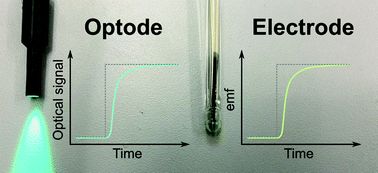
Analyst, 2019,144, 2208-2225
https://doi.org/10.1039/C9AN00268E
Chemical analysis in saliva and the search for salivary biomarkers – a tutorial review
A review of the uses of saliva biomarkers, detection methods and requirements for new biomarkers.

Analyst, 2018,143, 81-99
https://doi.org/10.1039/C7AN01571B
Molecular methods in electrochemical microRNA detection
High-throughput profiling/sensing of nucleic acids has recently emerged as a highly promising strategy for the early diagnosis and improved prognosis of a broad range of pathologies, most notably cancer. The review highlights some of the most promising strategies for electrochemical sensing of microRNA biomarkers.

Analyst, 2019,144, 114-129
https://doi.org/10.1039/C8AN01572D
Graphene-based aptasensors: from molecule–interface interactions to sensor design and biomedical diagnostics
Graphene-based aptasensors exhibit wide applications for the biomedical detection of DNA, proteins, small molecules, viruses, bacteria, and cells.

Analyst, 2018,143, 1526-1543
https://doi.org/10.1039/C8AN00081F
Microfluidic methods for aptamer selection and characterization
This review highlights advances and trends in microfluidic techniques for selecting and characterizing nucleic acid aptamers.

Analyst, 2018,143, 21-32
https://doi.org/10.1039/C7AN01046J
Field-effect sensors – from pH sensing to biosensing: sensitivity enhancement using streptavidin–biotin as a model system
This critical review provides an overview of sensitivity-enhancement strategies and a systematic, quantitative analysis of field-effect transistor (IS-FET/BioFET) sensor literature.

Analyst, 2017,142, 4173-4200
https://doi.org/10.1039/C7AN00455A
Recent developments in protease activity assays and sensors
Principles and signal generation mechanisms for both homogenous and heterogeneous proteases assays are reviewed in this article.
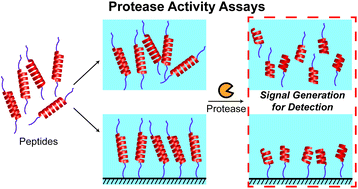
Analyst, 2017,142, 1867-1881
https://doi.org/10.1039/C6AN02647H
Gold nanoparticle-mediated signal amplification of liquid crystal biosensors for dopamine
A new design was developed for detection of dopamine using a boronic acid based amphiphile at aqueous–liquid crystal interface. The detection was highly enhanced in presence of gold nanoparticles.

Analyst, 2019,144, 1110-1114
https://doi.org/10.1039/C8AN02171F
A new enzyme immunoassay for alpha-fetoprotein in a separate setup coupling an aluminium/Prussian blue-based self-powered electrochromic display with a digital multimeter readout
A new immunoassay was designed for the detection of disease-related biomarkers (alpha-fetoprotein, AFP, as a model), coupling an aluminium (Al)/Prussian blue-based electrochromic display with a digital multimeter readout.
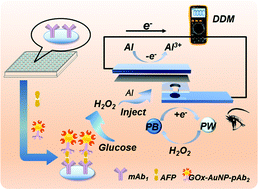
Analyst, 2018,143, 2992-2996
https://doi.org/10.1039/C8AN00839F
Insulin sensor cells for the analysis of insulin secretion responses in single living pancreatic β cells
Insulin sensor cells for the direct measurement of insulin secreted from single living pancreatic β cells were developed.

Analyst, 2019,144, 3765-3772
https://doi.org/10.1039/C9AN00405J
Widefield frequency domain fluorescence lifetime imaging microscopy (FD-FLIM) for accurate measurement of oxygen gradients within microfluidic devices
A widefield FD-FLIM system with fast acquisition speed is utilized to accurately characterize oxygen gradient distributions within microfluidic devices.
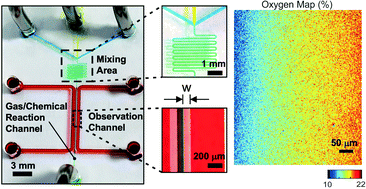
Analyst, 2019,144, 3494-3504
https://doi.org/10.1039/C9AN00143C
A novel turn-on fluorescent probe for selective sensing and imaging of glutathione in live cells and organisms
A novel 1-oxo-1H-phenalene-2,3-dicarbonitrile (OPD)-based fluorescent probe was developed to sense and image GSH in HeLa cells, different imatinib-resistant K562 cells, D. magna and zebrafish embryos.

Analyst, 2019,144, 3260-3266
https://doi.org/10.1039/C9AN00115H
Gold nanoparticle amplification strategies for multiplex SPRi-based immunosensing of human pancreatic islet hormones
In this work, we demonstrate the potential use of SPRi for secretion-monitoring of pancreatic islets, small micro-organs that regulate glucose homeostasis in the body.

Analyst, 2019,144, 2541-2549
https://doi.org/10.1039/C9AN00140A
Excitation-independent emission carbon nanoribbon polymer as a ratiometric photoluminescent probe for highly selective and sensitive detection of quercetin
In this study, sulfur–nitrogen co-doped carbon nanoribbon (SNCNR) polymers with stable dual-emission fluorescence were synthesized using a one-step traditional hydrothermal method of 6-mercaptopurine in an aqueous methanol solution.
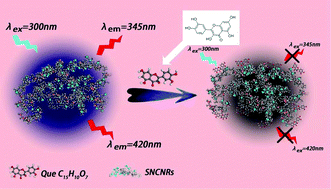
Analyst, 2019,144, 2256-2263
https://doi.org/10.1039/C9AN00094A
Thioflavin T specifically brightening “Guanine Island” in duplex-DNA: a novel fluorescent probe for single-nucleotide mutation
Here, we found that Thioflavin T (ThT) could specifically bind with a G-GGG unit (named as “Guanine Island”) in double stranded DNA (ds-DNA).

Analyst, 2019,144, 2284-2290
https://doi.org/10.1039/C8AN02430H
Dual role of BSA for synthesis of MnO2 nanoparticles and their mediated fluorescent turn-on probe for glutathione determination and cancer cell recognition
Scheme of the MnO2 NP-mediated fluorescence turn-off-on process of CDs with MnO2 NPs and GSH.

Analyst, 2019,144, 1988-1994
https://doi.org/10.1039/C8AN02501K
Colorimetric method for glucose detection with enhanced signal intensity using ZnFe2O4–carbon nanotube–glucose oxidase composite material
Preparation of peroxidase-mimic ZnFe2O4–carbon nanotube (CNT)–glucose oxidase (GOD) composite material for sensitive detection of glucose.

Analyst, 2019,144, 1831-1839
https://doi.org/10.1039/C8AN02330A
A highly sensitive electrochemical aptasensor for detection of microcystin-LR based on a dual signal amplification strategy
In this work, a sensitive and selective electrochemical aptasensor for detection of microcystin-LR was developed based on a dual signal amplification system consisted of a novel ternary composite and horseradish peroxidase.
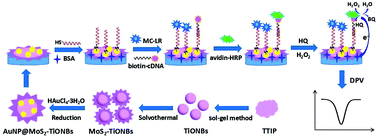
Analyst, 2019,144, 1671-1678
https://doi.org/10.1039/C8AN01971A
A graphene oxide/gold nanoparticle-based amplification method for SERS immunoassay of cardiac troponin I
A multiple signal amplification of a SERS biosensor was developed for sensitive detection of cTnI with the aid of GO/AuNP complexes.

Analyst, 2019,144, 1582-1589
https://doi.org/10.1039/C8AN02022A
Reversible fluorescence modulation of BSA stabilised copper nanoclusters for the selective detection of protamine and heparin
Depicting fluorescence sensing of protamine and heparin based on aggregation and disaggregation of copper nanoclusters.
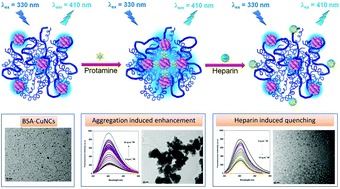
Analyst, 2019,144, 1799-1808
https://doi.org/10.1039/C8AN01703D
Rapid and simple detection of ascorbic acid and alkaline phosphatase via controlled generation of silver nanoparticles and selective recognition
A simple and novel strategy for detection of AA and ALP via controlled generation of Ag NPs and selective recognition.

Analyst, 2019,144, 1147-1152
https://doi.org/10.1039/C8AN01925H
Facile fabrication of fluorescent Fe-doped carbon quantum dots for dopamine sensing and bioimaging application
A facile Fe-doped carbon quantum dot based fluorescent sensor for dopamine sensing and bioimaging was constructed.

Analyst, 2019,144, 656-662
https://doi.org/10.1039/C8AN01741G
Transition metal-coordinated graphitic carbon nitride dots as a sensitive and facile fluorescent probe for β-amyloid peptide detection
Herein, we developed a sensitive graphitic carbon nitride quantum dot (gCNQD)-based fluorescent strategy for β-amyloid peptide monomer (Aβ) determination down to the ng mL−1 level for the first time.
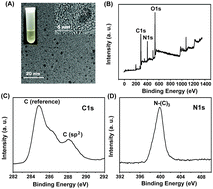
Analyst, 2019,144, 504-511
https://doi.org/10.1039/C8AN01620H
A conjugated carbon-dot–tyrosinase bioprobe for highly selective and sensitive detection of dopamine
A conjugated carbon-dot–tyrosinase bioprobe was first designed and applied for sensitive and selective dopamine detection in human serum.
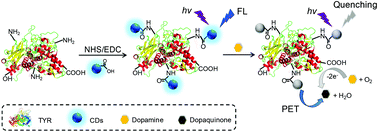
Analyst, 2019,144, 468-473
https://doi.org/10.1039/C8AN01659C
Solution-processed wrinkled electrodes enable the development of stretchable electrochemical biosensors
Wearable biosensors are critical for enabling real-time and continuous health monitoring and disease management.

Analyst, 2019,144, 172-179
https://doi.org/10.1039/C8AN01637B
Selectivity enhancement of amperometric nitric oxide detection via shape-controlled electrodeposition of platinum nanostructures
Selectivity in amperometric nitric oxide measurements was improved via controlling the shape of electrodeposited platinum nanostructures without any selective membranes.

Analyst, 2019,144, 258-264
https://doi.org/10.1039/C8AN01518J
A signal amplification strategy and sensing application using single gold nanoelectrodes
An electrochemical nanosensor was fabricated on a single gold nanoelectrode for thrombin sensing with high sensitivity via a signal amplification strategy.
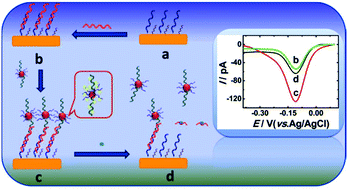
Analyst, 2019,144, 310-316
https://doi.org/10.1039/C8AN01474D
An “off–on” phosphorescent aptasensor for the detection of thrombin based on PRET
An “off–on” phosphorescent aptasensor was developed to detect thrombin based on PRET and the formation of an antiparallel G-quadruplex.
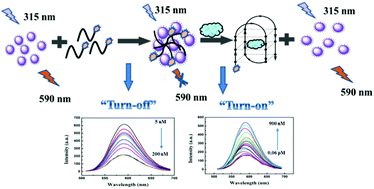
Analyst, 2019,144, 161-171
https://doi.org/10.1039/C8AN01571F
A pyrene-involved luminescent MOF for monitoring 1-hydroxypyrene, a biomarker for human intoxication of PAH carcinogens
A robust pyrene-involved MOF is developed as a luminescent platform for sensitive detection of 1-hydroxypyrene, a human intoxication biomarker of PAH carcinogens, by utilizing the efficient host–guest π–π charge transfer interactions.

Analyst, 2018,143, 3628-3634
https://doi.org/10.1039/C8AN00909K
Facile fabrication of a 3,4,9,10-perylene tetracarboxylic acid functionalized graphene–multiwalled carbon nanotube–gold nanoparticle nanocomposite for highly sensitive and selective electrochemical detection of dopamine
A PTCA-RGO-MWCNT-Au NP nanocomposite was facilely fabricated for highly sensitive and selective electrochemical detection of dopamine.
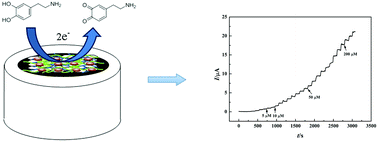
Analyst, 2018,143, 3075-3084
https://doi.org/10.1039/C8AN00559A
Carbon dots as analytical tools for sensing of thioredoxin reductase and screening of cancer cells
The addition of Cu2+ to a CD solution quenches the fluorescence emission of CDs while on the addition of TrxR, 2-mercaptopropanoic acid released from the surface of the CDs and emission from CDs was regained.
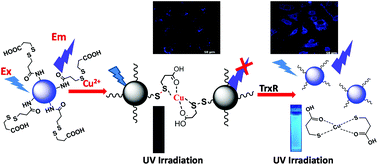
Analyst, 2018,143, 1853-1861
https://doi.org/10.1039/C7AN02040F
Detection of prostate specific antigen (PSA) in human saliva using an ultra-sensitive nanocomposite of graphene nanoplatelets with diblock-co-polymers and Au electrodes
Non-invasive detection of PSA in human saliva.
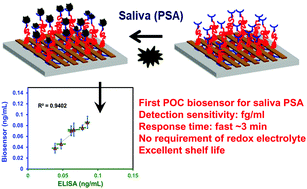
Analyst, 2018,143, 1094-1103
https://doi.org/10.1039/C7AN01932G
A novel turn-on fluorescent probe for the multi-channel detection of Zn2+ and Bi3+ with different action mechanisms
A novel multifunctional sensor, RSPT, was identified and developed for multichannel turn-on fluorescent responses to Zn2+ and Bi3+ in practice.

Analyst, 2018,143, 449-457
https://doi.org/10.1039/C7AN01591G
A tri-site fluorescent probe for simultaneous sensing of hydrogen sulfide and glutathione and its bioimaging applications
Hydrogen sulfide (H2S) and biothiol molecules, such as glutathione (GSH), cysteine (Cys), and homocysteine (Hcy), play an important role in biology.
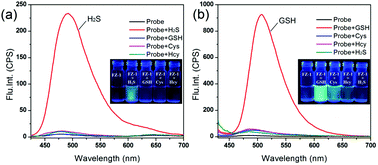
Analyst, 2018,143, 440-448
https://doi.org/10.1039/C7AN01588G
Surface enhanced Raman scattering sensor for highly sensitive and selective detection of ochratoxin A
An aptamer based SERS sensor was developed to detect picomolar concentrated ochratoxin solutions using an OPLS model.

Analyst, 2018,143, 339-345
https://doi.org/10.1039/C7AN01730H
A ratiometric fluorogenic probe for the real-time detection of SO32− in aqueous medium: application in a cellulose paper based device and potential to sense SO32− in mitochondria
A new water soluble and fluorogenic probe (L) that can demonstrate the specific ratiometric detection of a SO2 derivative (SO32−) in 100% aqueous medium and live cells has been designed and synthesized.

Analyst, 2018,143, 250-257
https://doi.org/10.1039/C7AN01368J
Functionalized gold nanoparticle-enhanced competitive assay for sensitive small-molecule metabolite detection using surface plasmon resonance
A functionalized gold nanoparticle-enhanced competitive assay was developed to overcome the sensitivity challenge associated with direct SPR sensing of small-molecule metabolites.

Analyst, 2018,143, 289-296
https://doi.org/10.1039/C7AN01680H
Rhodamine-based conjugated polymers: potentiometric, colorimetric and voltammetric sensing of mercury ions in aqueous medium
Herein, we report the synthesis and characterization of a conducting polymer film used as a simple and novel multi-signal sensor platform which demonstrates ion selective potentiometric, colorimetric and voltammetric responses in aqueous media.

Analyst, 2017,142, 3407-3415
https://doi.org/10.1039/C7AN00606C
Charged poly(N-isopropylacrylamide) nanogels for use as differential protein receptors in a turbidimetric sensor array
Due to the high cost and environmental instability of antibodies, there is precedent for developing synthetic molecular recognition agents for use in diagnostic sensors.
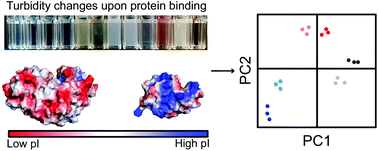
Analyst, 2017,142, 3183-3193
https://doi.org/10.1039/C7AN00787F
A surface plasmon field-enhanced fluorescence reversible split aptamer biosensor
Surface plasmon-enhanced fluorescence for the readout of a assay with low affinity split aptamer.

Analyst, 2017,142, 2995-3001
https://doi.org/10.1039/C7AN00970D
Sandwiched gold/PNIPAm/gold microstructures for smart plasmonics application: towards the high detection limit and Raman quantitative measurements
A smart plasmonic SERS platform, comprising a layer of a stimuli-responsive polymer sandwiched between two gold layers, is reported.
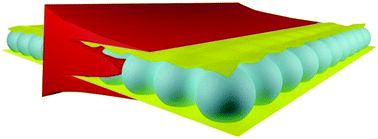
Analyst, 2017,142, 2974-2981
https://doi.org/10.1039/C7AN00419B
A fast, highly sensitive and selective assay of iodide ions with single-stranded DNA-templated copper nanoparticles as a fluorescent probe for its application in Kunming mice samples
A facile means for the detection of iodide ions with ssDNA-CuNPs due to the fluorescence decrease was proposed.
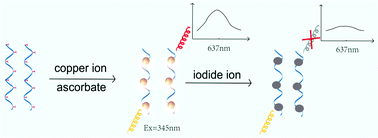
Analyst, 2017,142, 2781-2785
https://doi.org/10.1039/C7AN00595D
Enhancing the sensing specificity of a MoS2 nanosheet-based FRET aptasensor using a surface blocking strategy
The sensing specificity of a fluorescence resonance energy transfer (FRET)-based MoS2 nanosheet aptasensor to detect the malarial biomarker Plasmodium lactate dehydrogenase (pLDH) is significantly enhanced through surface passivation in this work.

Analyst, 2017,142, 2570-2577
https://doi.org/10.1039/C7AN00640C
Excellent peroxidase mimicking property of CuO/Pt nanocomposites and their application as an ascorbic acid sensor
Functional CuO/Pt nanocomposites were successfully constructed as peroxidase mimics for highly selective colorimetric detection of ascorbic acid.

Analyst, 2017,142, 2500-2506
https://doi.org/10.1039/C7AN00589J
An ultrasensitive multi-walled carbon nanotube–platinum–luminol nanocomposite-based electrochemiluminescence immunosensor
An ultrasensitive electrochemiluminescence (ECL) immunosensor for carbohydrate antigen 19-9 (CA19-9) detection using multi-walled carbon nanotube–platinum–luminol nanocomposites (MWCNT–Pt–luminol) as nanointerface and signal tags was designed.
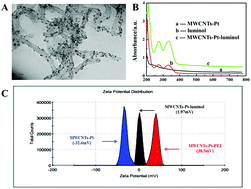
Analyst, 2017,142, 2253-2260
https://doi.org/10.1039/C7AN00417F
Quantum dot-based sensitive detection of disease specific exosome in serum
We report a stripping voltammetric immunoassay for the electrochemical detection of disease specific exosomes using quantum dots as electrochemical signal amplifiers.

Analyst, 2017,142, 2211-2219
https://doi.org/10.1039/C7AN00672A
A sensitive ratiometric electrochemical biosensor based on DNA four-way junction formation and enzyme-assisted recycling amplification
We develop a ratiometric electrochemical biosensor for DNA assay based on DNA four-way junction formation and enzyme-assisted recycling amplification.

Analyst, 2017,142, 1562-1568
https://doi.org/10.1039/C7AN00342K
Preparation of molecularly imprinted polymeric microspheres based on distillation–precipitation polymerization for an ultrasensitive electrochemical sensor
A highly sensitive electrochemical sensor based on a carbon paste electrode (CPE) modified with molecularly imprinted polymeric microspheres (MIPMSs) was developed for the determination of bisphenol A (BPA).

Analyst, 2017,142, 1091-1098
https://doi.org/10.1039/C7AN00059F
A microneedle biosensor for minimally-invasive transdermal detection of nerve agents
A microneedle array based biosensor for minimally invasive electrochemical monitoring of organophosphate (OP) nerve agents under the skin.
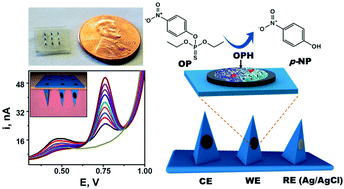
Analyst, 2017,142, 918-924
https://doi.org/10.1039/C6AN02625G
About this collection
A collection of recent reviews and research papers on the topics of bioanalytical sensors published in Analyst curated by the Analyst Editorial Office